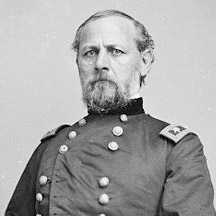Traveling on different routes out of
Chattanooga, Confederate Gen. Braxton Bragg moved his army
across the eastern edge of the Cumberland Plateau, while Gen. Edmond
Kirby Smith began the first major battle of the Confederates' Kentucky
Campaign at Richmond.
 |
| Patrick Ronayne Cleburne |
Gen. Smith ordered Cleburne to be ready to attack the next morning, promising him reinforcements. A Confederate victory is at hand.
The battle on the 30th began with a brief artillery duel. A Confederate attack on the enemy's right, forced the Federal troops to give way and retreat to Rogersville. But the Confederates carried the day. Of the 6,500 Federal troops who went into battle, 4,300 were taken prisoner. All total, the Confederates inflicted 5,353 casualties on the Federal force, while themselves suffering only 600 killed, wounded, or missing.
Having readied his troops overnight, Confederate Brig. Gen. Patrick Cleburne marched them north, driving back Federal skirmishers on his way to Kingston, Kentucky, to confront Federal Brig. Gen. Manson’s force near Zion Church. As the day progressed, additional troops joined both sides.
Having readied his troops overnight, Confederate Brig. Gen. Patrick Cleburne marched them north, driving back Federal skirmishers on his way to Kingston, Kentucky, to confront Federal Brig. Gen. Manson’s force near Zion Church. As the day progressed, additional troops joined both sides.
The Battle of Richmond, Kentucky, was one of the most complete Confederate victories of the war in the West. However, it will soon be offset by subsequent tactical failures, ending the campaign at the Battle of Perryville.
Having distinguished himself at the earlier Battle of Shiloh, Gen. Cleburne is now the hero of the Battle of Richmond. He will continue to lead with distinction on many more battlefields, rightly deserving the title, "The Stonewall of the West."
On this same day, the leadership in Washington D.C. is in full panic mode. The Army of Northern Virginia under Gen. Robert E. Lee has just defeated Maj. Gen. John Pope’s army at the Second Battle of Bull Run (or Second Manassas) in Virginia. And now the news of the Federal defeat in Kentucky.



